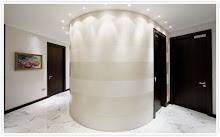Venetian plaster is different than other plastering techniques. It is multi-layered with a highly polished smooth surface which can be tinted with pigment, not covered with images or bright colours.
Even today it is a unique finish and this is mainly due to the processes and ingredients that have changed little since the first century AD.
The popularity of Venetian Plastering today is a result of its rediscovery in the Italian Renaissance. As a result of architects and artists embracing Venetian plaster it became a highly sought after finish for interior and exterior walls.
Essentially the base of Venetian Plaster has stayed the same - limestone, with a stone or marble powder for later layers.
In the fourth century BC Romans discovered that limestone, when mixed with volcanic material such as silica or alumina, would set and harden under all kinds of conditions, even under water. They also kept limestone in pits and dark cellars for three years to allow it to mature, and realised that when the limestone plaster was exposed to the atmosphere it could absorb atmospheric gases. This neutralised it, making it easier to use.
In the fifteenth century a lighter finish that resembled marble was developed – Marmorino. It was popularly used on the surfaces of buildings in Venice where it was necessary to keep them as light as possible. Many of the buildings had weak foundations and therefore were unsuitable for using marble slabs. The alternative, Marmorino, provided a smooth reflective surface that allowed the building to breathe in the moist Venetian lagoon environment.
Our modern version of Venetian Plaster is mainly due to an Italian architect called Carlo Scarpa. Many believe without him the skills of Venetian Plaster would have died away by now. In the mid 1900s he began using glues and acrylic resins. Along with other artisans he was responsible for reducing the layers required from seven to three.
The rich tradition of Venetian Plaster can now be found in Stucco Italiano’s MARMORINO VENEZIANO products which have adapted to the necessities of present-day application and colouring needs.
Wednesday, 30 September 2009
Subscribe to:
Post Comments (Atom)





No comments:
Post a Comment